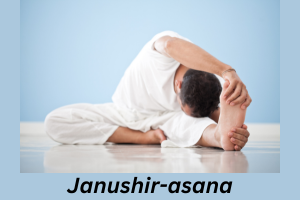Introduction
Janushirasana, commonly known as the Head-to-Knee Pose, is a seated forward bend pose that stretches the hamstrings, back, and shoulders while calming the mind.
“Janu” means “knee,” and “Shirsa” means “head,” signifying the pose’s intention to bring the head closer to the knee.

Janushirasana is a simple yet powerful pose practiced in various forms of yoga, especially in Hatha and Ashtanga yoga.
It serves as a gateway to deeper stretches and prepares the body for more advanced forward bends.
In addition to its physical benefits, Janushirasana promotes mental clarity and relaxation, making it an excellent pose for overall well-being.
Steps to Perform Janushirasana Yoga Pose
- Begin in Dandasana:
- Start by sitting on the floor or a yoga mat in Dandasana (Staff Pose) with your legs stretched out in front of you. Keep your back straight and your hands resting on the sides.
- Bend One Knee:
- Bend your right knee and bring the sole of your right foot against the inner left thigh. Let the right knee drop gently to the side while keeping the left leg extended straight forward.
- Inhale and Lengthen the Spine:
- As you inhale, raise your arms above your head and lengthen your spine. Focus on elongating your torso and creating space in the spine for the forward fold.
- Exhale and Fold Forward:
- On the exhale, begin to hinge at the hips and fold forward over your extended left leg. Keep your spine long, and avoid rounding your back as you reach for your left foot. If you can’t reach your foot, grab hold of your ankle or shin. If you’re more flexible, bring your forehead to your knee.
- Relax into the Pose:
- Hold this forward bend for 30 seconds to 1 minute, breathing deeply. With each exhale, try to deepen the stretch by bringing your head closer to your knee and your torso closer to your thigh.
- Switch Sides:
- To release, inhale and slowly lift your torso back up. Stretch your right leg out again, and repeat the pose on the opposite side by bending your left knee and stretching over your right leg.
Benefits of Janushirasana Yoga Pose
- Improves Flexibility:
Janushirasana deeply stretches the hamstrings, calves, and lower back muscles, improving flexibility over time. Regular practice helps loosen tight muscles, making other yoga poses more accessible. - Strengthens the Spine:
The pose elongates and strengthens the spine, which can alleviate tension in the back. It helps to maintain the natural alignment of the spine, improving posture and reducing the risk of back pain. - Enhances Digestion:
By folding forward and compressing the abdomen, Janushirasana stimulates digestion and helps to massage the digestive organs, including the liver and kidneys. This can help in relieving indigestion and bloating. - Calms the Mind:
Janushirasana is a forward-bending pose that promotes relaxation and introspection. It helps calm the nervous system, reduce stress, and alleviate anxiety by encouraging deep, steady breathing and a meditative state. - Stimulates the Kidney and Liver:
The forward bend in Janushirasana gently massages the internal organs, including the kidneys and liver. This stimulation can improve the functioning of these vital organs, helping in detoxification and overall health. - Relieves Menstrual Discomfort:
For women, Janushirasana can be especially beneficial during menstruation, as it helps reduce cramps and discomfort by gently stretching the pelvic region. - Increases Blood Circulation:
The folding motion in Janushirasana helps increase blood flow to the pelvic area, improving circulation throughout the body. This can energize the body and promote overall vitality. - Boosts Mental Clarity:
The focus required to hold Janushirasana can help improve concentration and mental clarity. The pose encourages mindfulness, helping to clear the mind and bring attention to the present moment.
Precautions and Contraindications for Janushirasana Yoga Pose
- Lower Back Issues:
Individuals with lower back problems or herniated discs should approach Janushirasana with caution. It is essential to keep the spine long and avoid rounding the back to prevent aggravating any existing conditions. - Hamstring Injuries:
If you have a hamstring strain or injury, be gentle while practicing Janushirasana. Overstretching can lead to further injury, so it’s important to only go as far as your body comfortably allows. - Knee Problems:
Those with knee injuries or arthritis should modify the pose by placing a cushion or blanket under the bent knee for support. Avoid forcing the knee into a deep bend, as this can cause discomfort or strain. - Pregnancy:
Pregnant women should modify Janushirasana by keeping the legs wider apart to make space for the belly. As the pregnancy progresses, it’s advisable to practice with the guidance of a yoga instructor. - Sciatica:
People with sciatica or nerve compression should be cautious while practicing Janushirasana. The forward bending motion can put pressure on the lower back, so it is important to ensure proper alignment and avoid deep bending if it causes discomfort. - Heart Conditions:
Individuals with heart conditions should avoid deep forward bends and practice the pose gently. It’s important to keep the breath steady and avoid holding the pose for long periods if it causes strain.
Conclusion
- Janushirasana, or the Head-to-Knee Pose, is a deeply therapeutic yoga posture that offers a wide range of physical and mental benefits.
- This pose, with its simple yet effective forward bend, encourages flexibility in the hamstrings, calves and spine while promoting mental relaxation and focus.
- Beyond its physical benefits, Janushirasana serves as a calming, introspective pose that helps relieve stress, anxiety, and tension.
- Its ability to stimulate the digestive organs and improve circulation makes it a powerful posture for holistic well-being.
- As with all yoga practices, it’s essential to listen to your body when practicing Janushirasana and avoid pushing yourself beyond your limits.
- With mindful practice, this pose can become a valuable tool for enhancing flexibility, promoting mental clarity, and nurturing the body from within.
- Whether you are a beginner or an experienced yogi, This asana is a rewarding pose that can be incorporated into your daily yoga routine for long-lasting benefits.
- Regular practice can help improve both physical posture and mental well-being, making it a valuable addition to any yoga practice.
